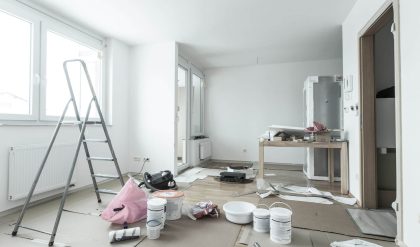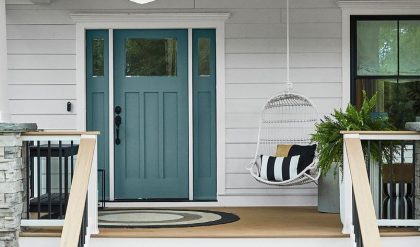
Improve Your Home’s Curb Appeal with These Simple Tricks
Your home’s exterior is the first impression visitors receive, a silent storyteller whispering tales of comfort, style, and personality. Boosting curb appeal isn’t about grand renovations; it’s about the thoughtful details that elevate the whole. Let’s unlock the secrets to transforming your home’s façade into a welcoming masterpiece.
I. The Power of First Impressions: Landscaping That Loves
The landscape is the stage, and your home, the star. Don’t let overgrown shrubs steal the spotlight. Strategic landscaping enhances your home’s beauty, creating a harmonious blend of nature and architecture.
-
Weed Out the Unwanted: A simple weed pull can make a dramatic difference. Neat borders and meticulously maintained lawns instantly upgrade your property’s appeal.
-
Strategic Planting: Think beyond just grass. Incorporate vibrant flowers in containers or strategically placed garden beds. Consider color palettes that complement your home’s exterior. A burst of color near the entrance is especially welcoming.
-
Trim and Shape: Overgrown bushes and trees can create a sense of neglect. Regular trimming keeps plants looking healthy and contained, providing a clean, polished look.
| Plant Type | Benefit | Quick Tip |
|---|---|---|
| Flowering shrubs | Color, texture, year-round interest | Choose low-maintenance varieties |
| Ornamental grasses | Movement, texture, visual interest | Plant in strategic locations for maximum impact |
| Conifers | Structure, year-round greenery | Consider different textures and shapes |
II. The Entrance Enchantment: A Welcoming Arrival
Your front door is the gateway to your home – make it memorable. A little attention to detail can transform a simple entrance into a stunning focal point.
-
A Fresh Coat of Paint: A new door color can revitalize your entire home’s exterior. Bold colors make a statement; subtle shades enhance the existing palette. Consider contrasting colors for the door and trim for added impact.
-
Hardware Upgrade: Replacing outdated doorknobs, house numbers, and mailboxes instantly elevates the entrance’s elegance. Choose styles that complement your home’s architectural style.
-
Outdoor Lighting: Strategically placed outdoor lighting not only enhances safety but also adds a touch of magic. Consider pathway lighting, porch lights, or even uplighting to highlight architectural details.
III. The Little Things That Make a Big Difference
Often, it’s the small details that truly elevate curb appeal. These simple tweaks can make a surprising difference:
-
Pressure Washing: A thorough pressure washing can remove dirt, grime, and mildew, revealing the underlying beauty of your home’s siding, driveway, and walkways.
-
Clean Windows: Sparkling clean windows make a home appear brighter and more inviting. Consider professional window cleaning for a streak-free shine.
-
Declutter the Driveway and Porch: Remove unnecessary items like old furniture, toys, or garden tools. A clutter-free space creates an impression of order and tranquility.
-
Mailbox Makeover: A new mailbox can add a surprising touch of personality and style.
IV. Beyond the Basics: Elevating Your Curb Appeal
For a more significant transformation, consider these additions:
-
New House Numbers: Stylish house numbers are a simple yet effective way to enhance your home’s curb appeal. Choose numbers that complement your home’s architectural style and color scheme.
-
Outdoor Seating: A comfortable outdoor seating area invites relaxation and enhances the overall aesthetic. Consider adding a bench, chairs, or a small patio set.
By implementing these simple tricks, you can dramatically transform your home’s curb appeal without breaking the bank. Remember, consistency is key. Regular maintenance and thoughtful attention to detail will keep your home looking its best, welcoming both guests and admiration.

Additional Information
Enhancing Curb Appeal: A Deeper Dive into Strategies and ROI
While a catchy title like “Improve Your Home’s Curb Appeal with These Simple Tricks” promises quick wins, achieving impactful curb appeal requires a more strategic and analytical approach. Simply implementing “tricks” may yield limited results. A truly enhanced curb appeal involves understanding the underlying principles of visual appeal, property value, and return on investment (ROI).
Beyond the “Tricks”: A Framework for Strategic Curb Appeal Enhancement
The success of any curb appeal improvement hinges on a holistic approach encompassing several key aspects:
1. Understanding the Target Audience and Property Context:
Before initiating any changes, analyze the target audience. Is the property in a historical district requiring preservation-conscious improvements? Does the neighborhood skew towards modern minimalist designs, or traditional landscaping? Ignoring the existing context will result in incongruous and potentially ineffective changes. For example, a vibrant, modern sculpture might be jarring in a Victorian-era neighborhood, while a meticulously manicured traditional garden might feel out of place in a contemporary setting.
2. Strategic Landscaping: More Than Just Mowing the Lawn:
Lawn care is foundational, but strategic landscaping goes beyond basic maintenance. It involves:
- Plant Selection: Choosing plants appropriate for the climate, soil type, and sun exposure is crucial. Using native plants often requires less maintenance and promotes biodiversity. Statistics show that homes with mature, well-maintained landscaping can command higher sale prices. A 2021 study by the National Association of Realtors found that landscaping improvements offer a significant ROI, with the average recouping over 100% of the investment cost.
- Layering and Focal Points: Create visual interest through layering – using a combination of trees, shrubs, groundcovers, and flowering plants. Establish focal points, such as a strategically placed fountain or a well-designed patio, to draw the eye and create a sense of welcoming.
- Hardscaping: Pathways, retaining walls, and patios add structure and functionality to the landscape. Consider the materials used – natural stone often creates a more upscale feel compared to concrete.
3. Exterior Painting and Refinishing:
The color palette significantly impacts curb appeal. Neutral colors generally offer greater flexibility and broader appeal, while bolder colors can create a strong statement, though they may limit the potential buyer pool. Beyond color, the condition of the paint is paramount. Chipped, faded paint drastically diminishes curb appeal. Repainting or refinishing siding, doors, and window frames delivers a significant improvement. A professional painting job often provides a higher ROI than a DIY attempt, due to superior quality and longevity.
4. Driveway and Walkway Enhancements:
Cracked or stained driveways and walkways detract from curb appeal. Repairing or replacing them can significantly enhance the overall impression. Consider materials that complement the house and landscaping style. Adding lighting along pathways enhances safety and creates a welcoming ambiance, especially in the evenings.
5. Decluttering and Maintenance:
This often overlooked aspect is crucial. Overgrown bushes, overflowing trash cans, and accumulated debris significantly diminish curb appeal. Regular maintenance, including cleaning gutters, weeding flower beds, and removing clutter, ensures a consistently appealing appearance.
Conclusion: A Data-Driven Approach to Curb Appeal
While “simple tricks” can offer minor improvements, a truly effective curb appeal strategy requires a more thorough and analytical approach. Understanding the property’s context, utilizing strategic landscaping, choosing appropriate colors, and ensuring meticulous maintenance are all essential elements. Analyzing local market trends, considering ROI on different improvements, and leveraging professional expertise whenever necessary will maximize the return on investment in enhancing your home’s curb appeal. The data clearly demonstrates that a well-planned and executed approach translates into increased property value and a more attractive living environment.






